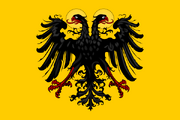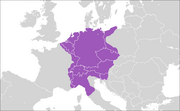

The Holy Roman Empire was a union of territories in Central Europe during the Middle Ages and the Early Modern period under a Holy Roman Emperor. The first Holy Roman Emperor was Otto I in 962 AD. The last was Francis II, who abdicated and dissolved the Empire in 1806 during the Napoleonic Wars. It was officially known as the Holy Roman Empire of the German Nation from the 16th century onwards. For much of its history the Empire consisted of hundreds of smaller sub-units, principalities, duchies, counties, Free Imperial Cities, as well as other domains. Despite its name, for much of its history the Empire did not include Rome within its borders.
The map at right shows the official extent of the Holy Roman Empire circa 1600, superimposed over today's national borders. Not all areas shown in purple were effectively part of the Empire. The Swiss Confederacy was de facto independent, as was the Dutch Republic. Other parts of the Netherlands were controlled by Spain, as was the part of northern Italy shown in purple.
Holy Roman Empire in 1632[]
At the height of the Thirty Years' War, the Holy Roman Empire was perilously fractured and close to being devastated by the war, until the arrival of Grantville changed everything. Although some states within the empire were not part of the Confederated Principalities of Europe or the United States of Europe, it was effectively defunct following the establishment of the CPoE and the USE. Bohemia, which had rebelled against the Holy Roman Emperor and started the war, was under the new reign of Albrecht von Wallenstein, who had allied himself with the USE. While Saxony under John George, and Brandenburg under George William refused to join the USE, it does not appear that they were motivated by any great loyalty to the Empire. In any event, Brandenburg and Saxony were separated from Imperial territory by the USE and Bohemia.
For all practical purposes, the Holy Roman Empire formally came to an end following the death of Emperor Ferdinand II in September 1634, when his son Ferdinand III publicly renounced all claims to the title "Holy Roman Emperor" and declared himself Emperor of Austria-Hungary. While it does not appear that he attempted to formally dissolve the Holy Roman Empire, these actions were effectively a statement that the Empire had ceased to exist in fact.
There are indications that the effective end of the Empire was not universally acknowledged outside of Central Europe.[1]
References[]
- ↑ In 1635: The Papal Stakes, ch. 35, Pedro Dolor refers to "the Holy Roman Empire's surrounded Rhine principalties".